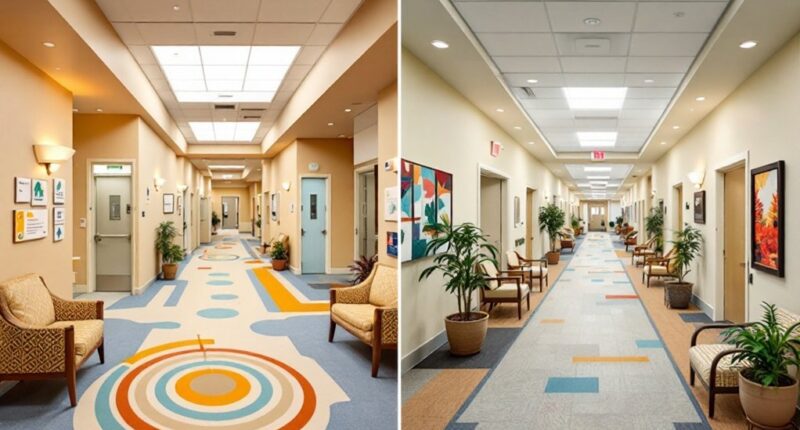Memory care facilities differ from traditional nursing homes through their specialized focus on cognitive conditions, maintaining higher staff-to-resident ratios and dementia-specific training programs. You'll find secured environments with simplified navigation systems, structured daily routines, and therapeutic activities designed explicitly for memory challenges. While nursing homes provide broad medical care, memory care facilities, averaging $65,000 annually, deliver targeted cognitive support and enhanced safety protocols. Further examination reveals numerous additional distinctions between these two senior care options.

When evaluating long-term care options for aging loved ones, understanding the fundamental distinctions between memory care facilities and traditional nursing homes becomes critically important for ideal placement decisions.
While nursing homes provide thorough medical care for various health conditions, memory care facilities specialize exclusively in supporting individuals with dementia and Alzheimer's disease through cognitive support and structured daily routines, delivering a higher staff-to-resident ratio for enhanced personalized attention.
You'll find that memory care facilities implement specialized environmental designs, incorporating secured entrances and exits to prevent wandering behaviors common among dementia patients, while maintaining simplified navigation systems and clear signage to reduce confusion and anxiety.
These architectural considerations contrast with traditional nursing homes, which typically offer greater freedom of movement but less structured environmental supports for cognitive challenges, demonstrating the specialized focus of memory care facilities on dementia-specific safety protocols.
The annual cost for memory care typically averages around sixty-five thousand dollars, reflecting the specialized nature of their programs and staffing requirements.
The staff expertise between these care options reveals significant variations, with memory care personnel receiving extensive training in dementia-specific interventions and behavioral management techniques. Daily activities are carefully structured to help residents maintain routine and stability, reducing anxiety common in memory-related conditions.
Your loved one will receive care from professionals who understand the nuances of cognitive decline and can adapt their approaches based on disease progression, whereas nursing home staff primarily focus on delivering skilled medical care across a broader spectrum of health conditions.
Memory care facilities emphasize individualized care plans that integrate cognitive therapies, physical activities, and social engagement opportunities specifically designed for residents with memory impairments.
The stage of dementia plays a crucial role in determining which care setting will best serve your loved one's needs.
You'll notice that these facilities actively encourage family participation in care planning and activities, creating a more collaborative approach to resident support than traditional nursing homes, which may offer less flexibility in adjusting plans for cognitive needs.
The distinction in care approaches manifests in the physical environment, daily programming, and staff training, creating specialized settings that address the unique challenges faced by individuals with memory-related conditions.
While both options provide thorough care services, memory care facilities maintain a singular focus on cognitive support and specialized safety measures, ensuring ideal care delivery for residents with dementia-related conditions.
Frequently Asked Questions
What's the Average Staff-To-Resident Ratio in Memory Care Facilities?
You'll typically find a staff-to-resident ratio of 1:5 or 1:6 during daytime hours in memory care facilities, though this varies by state regulations and facility policies.
During evening shifts, the ratio often shifts to 1:8-1:10, while overnight staffing may extend to 1:12.
These ratios exceed traditional nursing homes' standards, reflecting the intensive supervision and specialized care requirements of memory care residents.
Are Memory Care Facilities Covered by Medicare or Medicaid?
Medicare doesn't cover long-term memory care facility costs, though it may cover short-term skilled nursing care.
You'll find Medicaid's coverage varies by state, primarily covering nursing home care but not room and board in standalone memory care facilities.
However, you can access some memory care services through Medicaid's Home and Community-Based Services waivers, provided you meet your state's specific eligibility requirements and asset limitations.
How Often Can Family Members Visit Residents in Memory Care?
You'll find that most memory care facilities offer flexible visitation hours, typically allowing daily visits during waking hours (7 AM to 8 PM).
While specific policies vary by facility, you're generally welcome to visit whenever it best aligns with your loved one's daily routine and care schedule.
Some facilities even accommodate after-hours visits with advance notice, though they'll recommend visiting during structured activity times for ideal engagement and resident well-being.
What Security Measures Are in Place to Prevent Wandering?
Memory care facilities deploy multiple layers of security to prevent wandering, including electronically-secured entrances with keypad access, 24/7 monitoring systems, and WanderGuard™ technology that alerts staff when residents approach exits.
You'll find specialized environmental features like circular layouts, color-coded corridors, and enclosed outdoor spaces.
Staff maintain heightened supervision ratios of 1:6 during day shifts, while sophisticated motion sensors track resident movement throughout the facility.
Can Residents Bring Their Own Furniture to Memory Care Facilities?
While you'll find that most memory care facilities allow residents to bring personal furniture, specific policies vary by location and are governed by safety protocols and space limitations.
You'll need to verify individual facility guidelines, as some may restrict certain furniture types or sizes.
Your ability to personalize the living space typically depends on room dimensions, facility-provided furnishings, and safety considerations regarding fall risks and mobility requirements.









